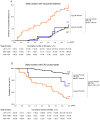The influence of sleep duration on patients with coronary artery disease: a four-year observational study
- PMID: 40391016
- PMCID: PMC12086895
- DOI: 10.3389/fendo.2025.1555880
The influence of sleep duration on patients with coronary artery disease: a four-year observational study
Abstract
Background: Coronary artery disease (CAD) is highly prevalent and fatal worldwide. In China, particularly in the southwest region, the association between CAD and sleep duration remains insufficiently understood. This study aims to investigate outcomes among CAD patients with varying sleep duration.
Methods: In a Southwest Chinese cohort, patients with CAD were categorized into three sleep duration groups: <6 hours, 6-8 hours, and >8 hours. Over a four-year follow-up, the endpoint including new-onset myocardial infarction and CAD-related deaths was recorded. The Fine-Gray model was employed to evaluate the estimated marginal occurrence probability of the target event. Additionally, Kaplan-Meier estimation and Cox regression analysis were conducted to further investigate the association between sleep duration and outcomes.
Results: The study enrolled 816 residents with CAD, who had an average age of 69.2 ± 8.3 years old, of whom 40.2% were male. Across the three sleep duration groups (6-8h, <6h, and >8h), the hazard ratios (HRs) with 95% confidence interval for new-onset myocardial infarction were: 1.00 (reference), 2.67 (1.57-4.55) (P < 0.001), and 0.98 (0.30-3.21) (P=0.970). For CAD-related mortality, the HRs were: 1.00 (reference), 5.20 (2.53-10.68) (P < 0.001), and 5.02 (1.59-15.80) (P=0.006). This trend was consistently observed in both the Fine-Gray model and subgroup analyses.
Conclusions: Both short (<6 hours/day) and long (>8 hours/day) sleep duration were linked to an elevated risk of cardiac mortality among CAD patients in Southwest China. Short sleep duration was also found to be associated with high myocardial infarction risk.
Keywords: CAD-related mortality; Southwest China; coronary artery disease; myocardial infarction; sleep duration.
Copyright © 2025 Ma, Wang, Wang, Tang, Qiu, Lu and Liu.
Conflict of interest statement
The authors declare that the research was conducted in the absence of any commercial or financial relationship that could be construed as a potential conflict of interest.
Figures





Similar articles
-
Effects of sleep habits on acute myocardial infarction risk and severity of coronary artery disease in Chinese population.BMC Cardiovasc Disord. 2021 Oct 7;21(1):481. doi: 10.1186/s12872-021-02251-8. BMC Cardiovasc Disord. 2021. PMID: 34620076 Free PMC article.
-
Sleep Duration and Mortality in Patients With Coronary Artery Disease.Am J Cardiol. 2019 Mar 15;123(6):874-881. doi: 10.1016/j.amjcard.2018.11.057. Epub 2018 Dec 18. Am J Cardiol. 2019. PMID: 30598240 Free PMC article.
-
Sex-Specific Associations Between Coronary Artery Plaque Extent and Risk of Major Adverse Cardiovascular Events: The CONFIRM Long-Term Registry.JACC Cardiovasc Imaging. 2016 Apr;9(4):364-372. doi: 10.1016/j.jcmg.2016.02.010. JACC Cardiovasc Imaging. 2016. PMID: 27056154 Free PMC article.
-
Poor long-term outcomes in stroke patients with asymptomatic coronary artery disease in heart CT.Atherosclerosis. 2017 Oct;265:7-13. doi: 10.1016/j.atherosclerosis.2017.07.029. Epub 2017 Jul 29. Atherosclerosis. 2017. PMID: 28825975
-
Association of Sleep Duration with the Morbidity and Mortality of Coronary Artery Disease: A Meta-analysis of Prospective Studies.Heart Lung Circ. 2015 Dec;24(12):1180-90. doi: 10.1016/j.hlc.2015.08.005. Epub 2015 Sep 7. Heart Lung Circ. 2015. PMID: 26422535 Review.
Cited by
-
Sleep disorder is associated with increased risk of major adverse cardiovascular events in patients with schizophrenia.Front Neurol. 2025 Jul 25;16:1601319. doi: 10.3389/fneur.2025.1601319. eCollection 2025. Front Neurol. 2025. PMID: 40786633 Free PMC article.
References
Publication types
MeSH terms
LinkOut - more resources
Full Text Sources
Medical
Miscellaneous

